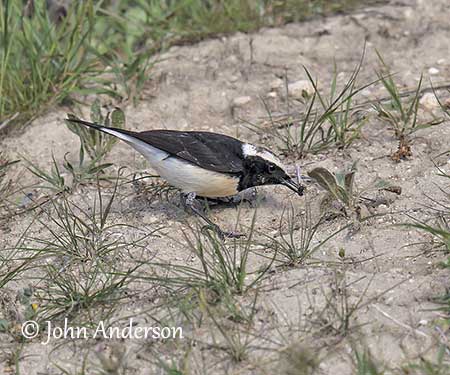
Fr: Traquet de Chypre
Ang: Cyprus Wheatear
All: Zypernsteinschmätzer
Esp: Collalba Chipriota
Ita: Monachella di Cipro
Nd: Cyprustapuit
Sd: cypernstenskvätta
Photographers:
John Anderson
John Anderson Photo Galleries
Ingo Waschkies
Bird Photography
Text by Nicole Bouglouan
Sources:
HANDBOOK OF THE BIRDS OF THE WORLD Vol 11 by Josep del Hoyo, Andrew Elliott and David Christie - Lynx Edicions - ISBN: 849655306X
THE HANDBOOK OF BIRD IDENTIFICATION FOR EUROPE AND THE WESTERN PALEARCTIC by Mark Beaman, Steve Madge - C. Helm - ISBN: 0713639601
BIRDS OF THE MIDDLE EAST by R.F. Porter, S. Christensen, P Schiermacker-Ansen C.Helm - ISBN: 0713670169
BIRDS OF AFRICA SOUTH OF THE SAHARA by Ian Sinclair and Peter Ryan - Princeton University Press Princeton and Oxford - ISBN: 0691118159
Wikipedia, the free encyclopaedia
Cyprus Bird watching Tours - BIRD is the WORD
Separation of Cyprus Pied Wheatear from Pied Wheatear
St Andrews Research Repository
Breeding habitat preference and foraging of the Cyprus Wheatear
Reproductive success and productivity of the Cyprus Wheatear
Cyprus Wheatear
Oenanthe cypriaca
Passeriformes Order – Muscicapidae Family
INTRODUCTION:
The Cyprus Wheatear is endemic to Cyprus where it breeds, but it is migratory and spends the winter S to NE Africa.
It is today a full species, but was formerly a subspecies of the Pied Wheatear, on the basis of some different features such as song and lack of sexual plumage dimorphism.
The Cyprus Wheatear is mainly arboreal and uses more aerial sallies than other Oenanthe species. It sings from high perches (5-10 metres) and utters series of high-pitched buzzing notes.
This species is not globally threatened. It is abundant and widespread in Cyprus, and the population is currently stable.

DESCRIPTION OF THE BIRD:
Biometrics:
Length: 13-14 cm
The Cyprus Wheatear male in breeding plumage closely resembles Pied Wheatear, but it has shorter wings and tail, and has 20% less in body mass.
It has black mantle, wings, chin, throat and face, contrasting strongly with the white crown and nape and rest of underparts. We can see a dark brown mottling on the white crown, and an extensive buff wash below.
The black of the upperparts extends to the upper rump. The tail is black with white bases to outer rectrices, forming the typical T of wheatear’s tail.
Bill, legs and feet are black. The eyes are blackish-brown.
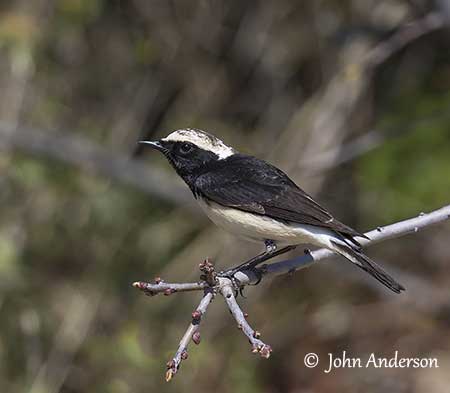
The non-breeding male is duller, with more dark areas on crown and nape, some faint, narrow white bars on face, chin and throat, and grey-buff fringes to black mantle. The supercilium is buffy-white.
The adult female shows similar plumage pattern, but she has brown to greyish-black upperparts and rather dark brown crown, surrounded by whitish stripe. During summer, she is very similar to male, but with dark areas on crown and nape.
The first winter male resembles breeding female. It has pale buff fringes to back feathers.
The juvenile is similar to female, but it has head, back and breast mottled buff and brown.
RANGE:
The Cyprus Wheatear breeds on Cyprus, and spends the winter in NE Africa, especially in S Sudan and Ethiopia.
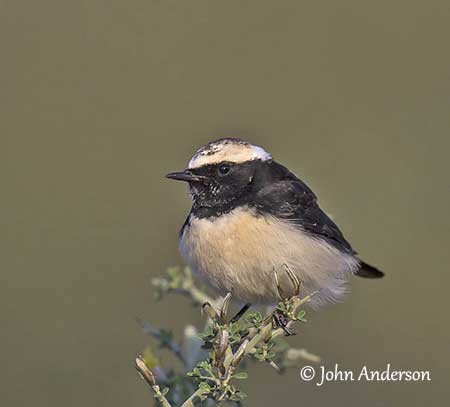
HABITAT:
The Cyprus Wheatear breeds in forest clearings and open pine woodland in mountains, stony hillsides and mountains slopes with bushes and scattered trees, natural and farmed lowlands, gardens and suburban areas.
During winter, it can be found in open country, dry stony plains, fields and grasslands.
CALLS AND SONGS: SOUNDS BY XENO-CANTO
The Cyprus Wheatear’s typical call is a hard “zack-zack”. The distinctive song recalls a cicada, but less harsh, a rapidly repeated purring “bizz-bizz-bizz…” for quite long periods. The song often ends in high-pitched, drawn-out piping note.
The Cyprus Wheatear sings sometimes in flight, but it usually sings from high perches such as treetop, building or wire.
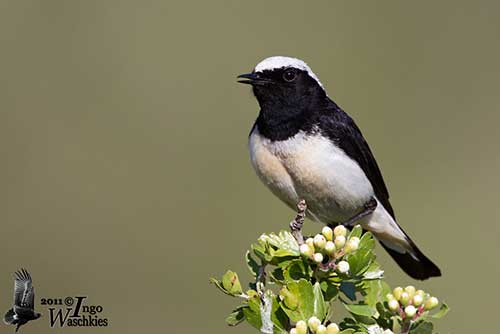
BEHAVIOUR IN THE WILD:
The Cyprus Wheatear feeds on invertebrates, mainly insects and caterpillars, and probably takes some other type of small prey.
It is mainly arboreal and performs numerous aerial sallies to catch prey. Its hunting behavior includes less hopping on the ground than in other members of genus Oenanthe.
Information about the courtship behavior is currently lacking, but we can suggest that the black-and-white plumage pattern of the breeding male is displayed and enhanced by adapted postures and movements.

The Cyprus Wheatear is migratory. It leaves the breeding grounds in late August/September to early November. They migrate by passing through S Israel, Jordan and Egypt in October/November, to spend the winter in Sudan and Ethiopia, between November and March.
The return migration occurs mid-March to mid-April. The main arrivals on Cyprus occur in late March. Males usually arrive 1-2 weeks before females, probably to establish a territory.
The Cyprus Wheatear has direct flight during which the black-and-white tail pattern is conspicuous.
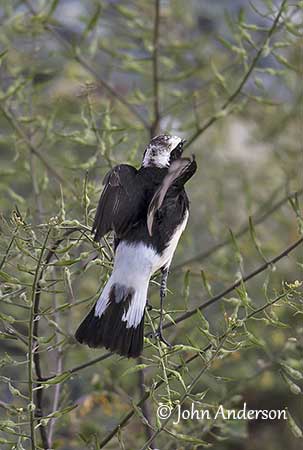
REPRODUCTION OF THIS SPECIES:
The Cyprus Wheatear usually produces two broods per season. The breeding season takes place between April and July, but it starts three weeks later at higher elevations than in plains.
The nest is placed in hole in earth bank, in stone or mud wall, behind the loose bark of eucalypt tree or under stone. It can be placed too on artificial structures including flowerpot, shed shelves, nest-box, empty can… The nest itself is a loose bulky cup made with grass and roots.
The female lays 4-5 pale blue eggs with red-brown markings. The incubation lasts 13 days. The chicks leave the nest about 13-15 days after hatching. Nest survival is high with 4 chicks alive one month after fledging.
PROTECTION / THREATS / STATUS:
The Cyprus Wheatear has restricted breeding range on Cyprus. It is abundant, often commonest in hills and mountains, and least common in plains.
The only known threat is from bird-catchers, and needs enforcements of laws against trapping, and monitoring of the situation.
The population was estimated to number 40,000/100,000 pairs in 2015, and this population is suspected to be stable.
The Cyprus Wheatear is currently evaluated as Least Concern.
